Imagination Announces B-Series GPU IP: Scaling up with Multi-GPU
by Andrei Frumusanu on October 13, 2020 4:00 AM EST- Posted in
- GPUs
- Imagination Technologies
- SoCs
- IP
Configurations - Up to 4 GPUs at 6TFLOPs
Starting off with the smallest GPU building blocks, it’s good to remind ourselves how an Imagination GPU looks like – the following is from last year’s A-Series presentation:
| PowerVR GPU Comparison | ||||
| AXT-16-512 BXT-16-512 |
GT9524 | GT8525 | GT7200 Plus | |
| Core Configuration |
1 SPU (Shader Processing Unit) - "GPU Core" 2 USCs (Unified Shading Clusters) - ALU Clusters |
|||
| FP32 FLOPS/Clock MADD = 2 FLOPs MUL = 1 FLOP |
512 (2x (128x MADD)) |
240 (2x (40x MADD+MUL)) |
192 (2x (32x MADD+MUL)) |
128 (2x (16x MADD+MADD)) |
| FP16 Ratio | 2:1 (Vec2) | |||
| Pixels / Clock | 8 | 4 | ||
| Texels / Clock | 16 | 8 | 4 | |
| Architecture | A-Series B-Series |
Series-9XTP (Furian) |
Series-8XT (Furian) |
Series-7XT (Rogue) |
Fundamentally and at a high-level, the new B-Series GPU microarchitecture looks very similar to the A-Series. Microarchitecturally, Imagination noted that we should generally expect a 15% increase in performance or increase in efficiency compared to the A-Series, with the building blocks of the two GPU families being generally the same save for some more important additions such as the new IMGIC (Imagination Image Compression) implementation which we’ll cover in a bit.
An XT GPU still consists of the new SPU design which houses the new more powerful TPU (Texture Processing Unit) as well as the new 128-wide ALU designs that is scaled into ALU clusters called USCs (Unified Shading Clusters).
Imagination’s current highest-end hardware implementation in the BXT series is the BXT 32-1024, and putting four of these together creates an MC4 GPU. In a high-performance implementation reaching up to 1.5GHz clock speeds, this configuration would offer up to 6TFLOPs of FP32 computing power. Whilst this isn’t quite enough to catch up to Nvidia and AMD, it’s a major leap for a third-party GPU IP provider that’s been mostly active in the mobile space for the last 15 years.
The company’s BXM series continues to see a differentiation in the architecture as some of its implementations do not use the ultra-wide ALU design of the XT series. For example, while the BXM-8-256 uses one 128-wide USC, the more area efficient BXM 4-64 for example continues to use the 32-wide ALU from the 8XT series. Putting four BXM-4-64 GPUs together gets you to a higher performance tier with a better area and power efficiency compared to a larger single GPU implementation.
The most interesting aspect of the multi-GPU approach is found in the BXE series, which is Imagination’s smallest GPU IP that purely focuses on getting to the best possible area efficiency. Whilst the BXT and BXM series GPUs until now are delivered as “primary” cores, the BXE is being offered in the form of both a primary as well as a secondary GPU implementation. The differences here is that the secondary variant of the IP lacks a firmware processor as well as a geometry processing, instead fully relying on the primary GPU’s geometry throughput. Imagination says that this configuration would be able to offer quite high compute and fillrate capabilities in extremely minuscule area usage.
| PowerVR Hardware Designs GPU Comparison | ||||||
| Family | Texels/ Clock |
FP32/ Clock |
Cores | USCs | Wavefront Width |
MC Design |
| BXT-32-1024 MC1 | 32 | 1024 | 1 | 4 | 128 | P |
| BXT-16-512 MC1 | 16 | 512 | 1 | 2 | 128 | P |
| BXM-8-256 MC1 | 8 | 256 | 1 | 1 | 128 | P |
| BXM-4-64 MC1 | 4 | 64 | 1 | 1 | 32 | P |
| BXE-4-32 Secondary | 4 | 32 | 1 | 1 | 16 | S |
| BXE-4-32 MC1 | 4 | 32 | 1 | 1 | 16 | P |
| BXE-2-32 MC1 | 2 | 32 | 1 | 1 | 16 | P |
| BXE-1-16 MC1 | 1 | 16 | 1 | 1 | 8 | P |
Putting the different designs into a table, we’re seeing only 8 different hardware designs that Imagination has to create the RTL and do physical design and timing closure on. This is already quite a nice line-up in terms of scaling from the lowest-end area focused IP to something that would be used in a premium high-end mobile SoC.
| PowerVR MC GPU Configurations | ||||||
| Family | Texels/ Clock |
FP32/ Clock |
Cores | USCs | Wavefront Width |
MC Design |
| BXT-32-1024 MC4 | 128 | 4096 | 4 | 16 | 128 | PPPP |
| BXT-32-1024 MC3 | 96 | 3072 | 3 | 12 | 128 | PPP |
| BXT-32-1024 MC2 | 64 | 2048 | 2 | 8 | 128 | PP |
| BXT-32-1024 MC1 | 32 | 1024 | 1 | 4 | 128 | P |
| BXT-16-512 MC1 | 16 | 512 | 1 | 2 | 128 | P |
| BXM-8-256 MC1 | 8 | 256 | 1 | 1 | 128 | P |
| BXM-4-64 MC4 | 16 | 256 | 4 | 4 | 32 | PPPP |
| BXM-4-64 MC3 | 12 | 192 | 3 | 3 | 32 | PPP |
| BXM-4-64 MC2 | 8 | 128 | 2 | 2 | 32 | PP |
| BXM-4-64 MC1 | 4 | 64 | 1 | 1 | 32 | P |
| BXE-4-32 MC4 | 16 | 128 | 4 | 4 | 16 | PSSS |
| BXE-4-32 MC3 | 12 | 96 | 3 | 3 | 16 | PSS |
| BXE-4-32 MC2 | 8 | 64 | 2 | 2 | 16 | PS |
| BXE-4-32 MC1 | 4 | 32 | 1 | 1 | 16 | P |
| BXE-2-32 MC1 | 2 | 32 | 1 | 1 | 16 | P |
| BXE-1-16 MC1 | 1 | 16 | 1 | 1 | 8 | P |
The big flexibility gain for Imagination and their customers is that they can simple take one of the aforementioned hardware designs, and scale these up seamlessly by laying out multiple GPUs. On the low-end, this creates some very interesting overlaps in terms of compute abilities, but offer different fillrate capabilities at different area efficiency options.
At the high-end, the biggest advantage is that Imagination can quadruple their processing power from their biggest GPU configuration. Imagination notes that for the BXT series, they no longer created a single design larger than the BXT-32-1024 because the return on investment would simply be smaller, and involve more complex timing work than if a customer would simply scale performance up via a multi-core implementation.


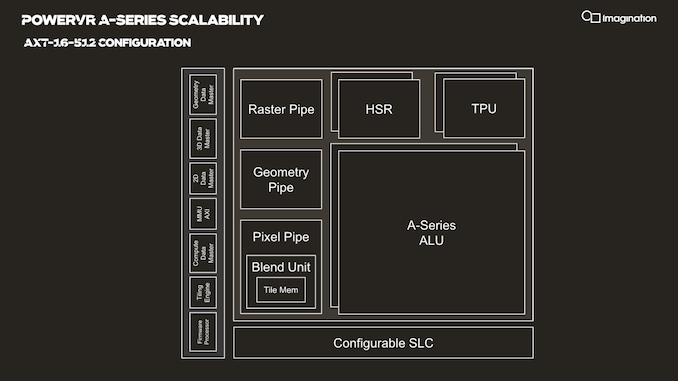
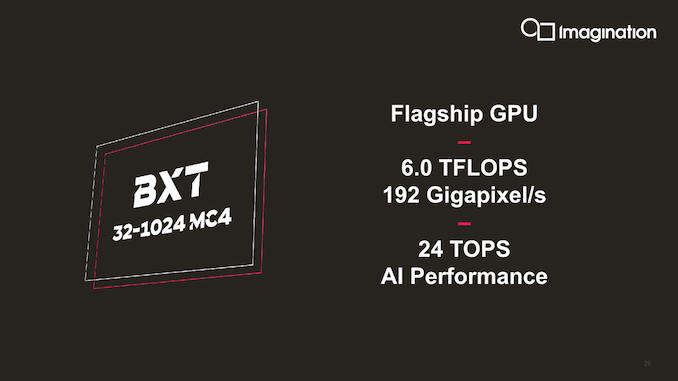
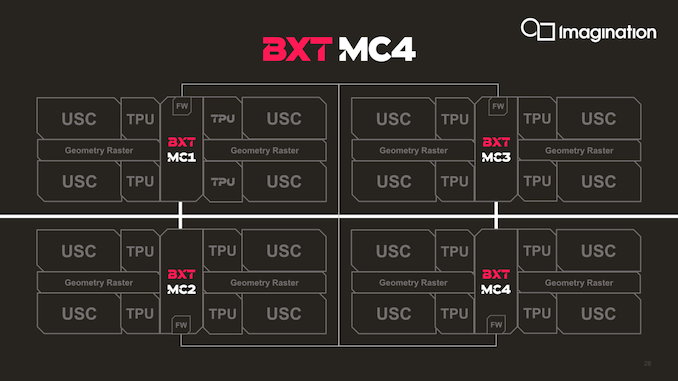
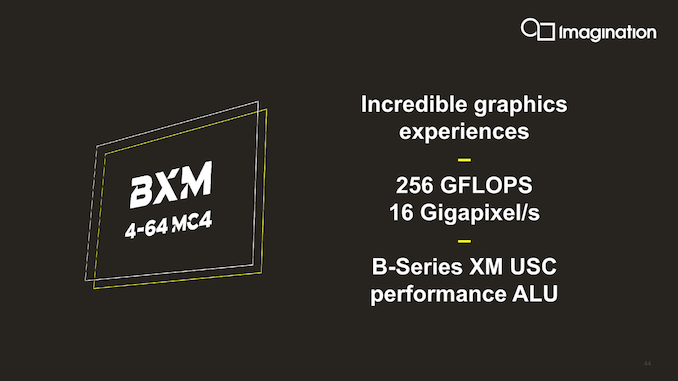
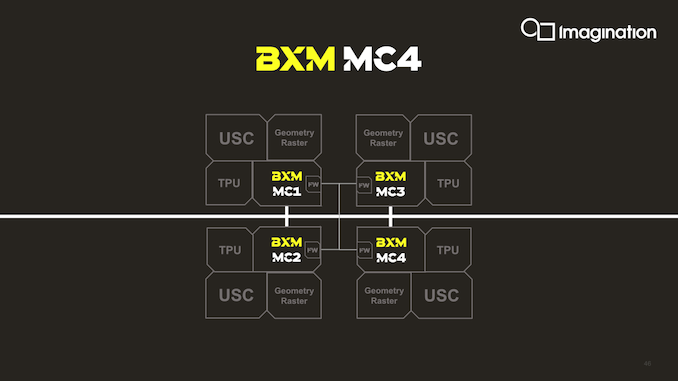
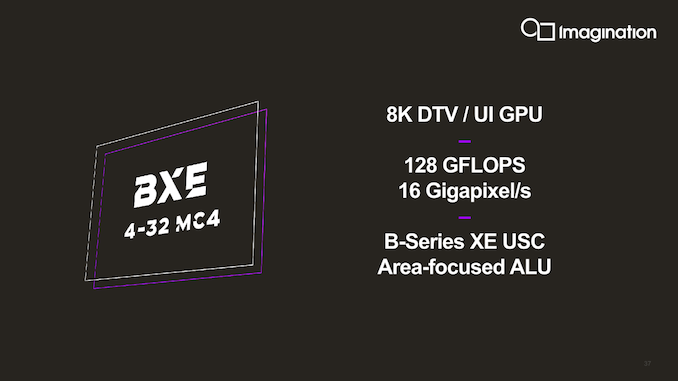









74 Comments
View All Comments
Obi-Wan_ - Tuesday, October 13, 2020 - link
Is this something that could transition to the desktop consumer space at some point? Either the Imagination IP or just the pull/push change.yeeeeman - Tuesday, October 13, 2020 - link
I am also wondering about this.To me it seems a bit strange why they don't take this step given that their revenues from mobile are getting slimmer and slimmer.
Arsenica - Tuesday, October 13, 2020 - link
Imagination Technologies may be British but it's owned via shell-companies by the Chinese government. Finding viable revenue streams no longer matters to them.This product may eventually transition to China-only PCs, but in the meantime (as it's implied in Innosilicon PR) it's targeted for Chinese data centers.
Threska - Wednesday, October 14, 2020 - link
Getting the Apple contract is indeed a big deal.https://technode.com/2020/04/15/imagination-techno...
Otritus - Tuesday, October 13, 2020 - link
I would imagine the consideration is money and competition. Imagination has no mindshare in the consumer market, and lacks many gaming-centric features (and good drivers) that would essentially eliminate adoption. The MGPU seems like it will be the future of gpu computing, but right now putting multiple slabs of silicon together and efficiently connecting them is expensive and power hungry which is undesirable.myownfriend - Tuesday, October 13, 2020 - link
What gaming centric features are they missing and how do you know they have shitty drivers?Otritus - Wednesday, October 14, 2020 - link
To my knowledge, their gpus do not currently support APIs such as DX12, lack a freesync/gsync competitor, reduced input latency, game streaming, etc. In terms of drivers they have no public drivers for windows or linux, meaning their drivers are unoptimized for desktop usage.myownfriend - Wednesday, October 14, 2020 - link
You're conflating a few things. Adaptive sync or Freesync is a feature of the display controller not the GPU. As has been stated, Apple has used Imagination's GPU IP for years and that includes the iPad Pro which supports dynamic refresh rates.Game streaming is a way that software uses a GPUs hardware decoder. All it would require is something like Moonlight supporting it.
I don't know what reduced input latency is supposed to refer to here since that has to do with a bunch of things that aren't the GPU.
I can't say for certain if they support DirectX 12 but they have supported OpenGL, Vulkan, and DirectX 11 for a long time. Considering many DirectX 11 GPU were able to support DX12 via a driver update, that's very likely something that they could do the same. If they can't then they would still be an option for Linux users.
Lastly, Imagination makes GPU IP meaning they don't manufacture actual chips. They license out designs so you're not gonna go to Imagination's website and see download list for their drivers. You can, however, look at Imagination's YouTube channel and see their cards running on Linux and Windows desktops so those drivers exist.
Kangal - Friday, October 16, 2020 - link
He's "Technically wrong" but from the consumer's viewpoint he's entirely right. There's a lot of work ImaginationTechnologies have to do to get their PowerVR GPUs to the desktop space then catch-up and compete against the likes of Nvidia's Ampere GPUs (industry standard).Normally, I would say that's easy. PowerVR has actually been an innovator and sometimes a leader in the GPU field, albeit from the shadows. But now? I doubt it.
Rant:
Firstly with 2020 being what it is. More importantly, the company is shifting massively with their CEO ousted, board members changing, and their Senior Engineers leaving after the aggressive Chinese buyout. The British seem to be angry about the whole thing, but it was so predictable, they're too naive. I'm not sure if what's left of PowerVR will have the leadership and talent anymore to get the job done. Perhaps these A-Series and B-Series are the end of their hard work, and in a few years time they will hit the wall (kinda like Intel did after SkyLake). Their short-handed won't affect Apple much, since they actually have their own GPU designers and don't rely on PowerVR much anymore. So I can see these valuable staff being poached by Apple-SoC, ARM-Mali or even Qualcomm-Adreno teams. Hopefully they don't add to the monopoly with Nvidia/AMD teams.
myownfriend - Friday, October 16, 2020 - link
I can agree with all that. It would be very difficult for them to break into a field that's been team red and team green for some people's entire lives. If they do fall apart, I'd say Nvidia would be the worst case scenario as their recent purchase of ARM is allowing them to wield a gross amount of power.